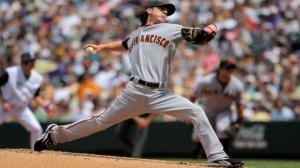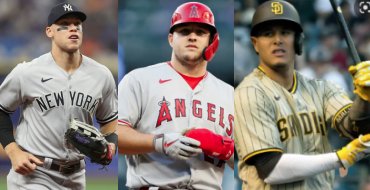Our last preview takes us out west to the National League West Division. It’s the Division that houses the World Series champions, the San Francisco Giants. They’re obviously heavily favored but we’ll take a look at them as well as their division rivals — if you can call them rivals at all. Though the Padres finished just 2 games behind the Giants, the odds indicate that they are serious underdogs. Bets and odds are taken from Sportsbook’s Baseball Futures betting.

San Francisco Giants
Odds of Winning World Series: +1500
Odds of Winning NL Pennant: +700
Odds of Winning NL West: +150
2010: 92-70, 1st in NL West
July 4th: The Nation celebrates its Independence day — and the Giants look up at the standings, finding themselves 7.5 games behind the Padres and with a record just one game over .500 at 41-40. Certainly at this point no one was thinking “World Series bound,” much less “World Series Champs.” However, a serious reversal in fortunes was to come from unlikely sources that would propel the Giants into relevance, before they eventually took the NL West by a mere two games, the second smallest margin of division win in the league (the Tampa Bay Rays finished just one game ahead of the Yankees).
What brought about the change? Minor league vet Andres Torres’ uncanny improvement proved to be a serious boon. The 33 year old non-prospect came into the majors not expected to do much, but low and behold, he posted the second highest VORP of the Giants’ batters and also proved to be a defensive demon in the field. Pat Burrell was waived by Tampa and the Giants immediately tendered him a contract, causing him to switch from the AL to the NL, and the result was remarkable. Burrell went on to hit .266, his highest since 2006, the year he hit his career high 33 homers. Also, his slugging percentage was .509, nearly a full .7 higher than his career average. Buster Posey also was called up the same day as Burrell’s signing and he went on to replace the disappointing Bengie Molina, who was dealt to the Rangers. Their top prospect Madison Bumgarner rediscovered his fast ball at just the right point and was called back up to the majors. Juan Uribe stepped up to fill the hole left by the perpetually injured Edgar Renteria and did a solid job. Cody Ross got very hot, another waiver wire claim.
This perfect storm of events would culminate in the Giants’ win percentage over the period of July 5th until the end of the season being .630, 0.66 higher than their win percentage for the season. Truly, the Giants could not have experienced a better stroke of good old fashioned luck than they did. They had replaced 5 of their 8 starters with minor leaguers and stop-gap former scrubs and managed to CLIMB in the standings, to the surprise of themselves and everyone else in the MLB.
For all the improvement in offense, it wasn’t truly the offense that won the Giants their title. Their batting was still well below the league average. They averaged just 4.17 runs per game through their first 81 games and it improved to a respectable 4.43 over the last 81 games. Still, the result was a quite average offense. The caveat of the Giants’ success was their pitching.
Consider this ridiculously good stat. Over the month of September the Giants pitching staff held the opposing teams to under 2 runs a game, 1.92, over a span of 26 games. Take out the anomolous 10 run game in high altitude Colorado and the figure drops to an average of 1.6 a game. That makes winning extremely easy and the Giants feel they have the pieces in tact to make another run. It will again rely heavily on their outstanding pitching staff led by super stud Tim Lincecum, Matt Cain, Madison Bumgarner, and Barry Zito, but if they pitch any where near as good as they did down the stretch of 2010, a repeat championship would not only be probable, but inevitable.
San Diego Padres
Odds of Winning World Series: +10000
Odds of Winning NL Pennant: +4000
Odds of Winning NL West: +1000
2010: 90-72, 2nd in NL West
For all the failures of the 2010 Mariners, the Padres were expected to be the National League equivalent. Both teams were built on defense and pitching and expected that method of team building to equate to a championship. The Mariners went on to a dreadful 61-101 record while the Padres improved by 15 wins and nearly stole the division away from the Mariners, after being projected to win a mere 73 wins by PECOTA projections, which are known for being deadly accurate.
Perhaps it wasn’t completely unexpected by everyone, as the team did close 2009 with a 37-25 record over the final 62 games. Like the Giants, the Padres’ pitching was outstanding. Unlike the Giants, it was nearly record setting. Their WXRL (Win Expectation Above Replacement, Lineup Adjusted) posted by the bullpen was the 5th highest…of all time. The San Diego pitchers strikeout rate jumped from 18.9% in 2009 to a very solid 21.3% in 2010, which enabled their average to below average fielders to do less, a problem for them in 2009 and the beginning of 2010, before replacing Kevin Kouzmanoff (who was traded) with Chase Headley (who was previously playing out-of-position), adding Jerry Hairston, Jr., and signing Yorvit Torrealba.
As good as their pitching was, their offense was average — at best. No one expected much from their hitters, and they also happen to play in a very pitcher-friendly (especially difficult for left handed batters) ballpark, which unfortunately plays right into the Padres’ weaknesses as two of their rotation hitters, Will Venable and Adrian Gonzalez, are lefties.
A lot of baseball pundits will claim that they were not surprised by the 2010 Padres and that the win predictions set by PECOTA and Vegas oddsmakers were precariously low. They are utterly full of crap. No one expected this Padres team to win 80 games, much less 90. The team is likely to make some moves to trade older players and obtain younger prospects and younger major leaguers to fit in with the motif of young players they have, but given the strength of the pitching and defense, it will again only take average production on offense for the Padres to be a successful and winning team again this year.
Colorado Rockies
Odds of Winning World Series: +2500
Odds of Winning NL Pennant: +1200
Odds of Winning NL West: +150
2010: 83-79, 3rd in NL West
For as bad of a pitchers’ park as Coors Field is, the Rockies have one of the best aces in the National League in Ubaldo Jimenez and still managed to post the average for run production, rougly 4.42 per game, astoundingly low considering the high altitude home run bombing park they play in. This ranks as the best pitching staff in Rockies history, and coupled with their outstanding offense, it makes the Rockies a contender, not just this year, but for years to come, as they set up what could be the first Colorado Rockies dynasty.
They won the NL Pennant in 2007, made the playoffs in 2009, and weren’t eliminated from last year’s playoffs until the final week of the regular season. The trio of superstars that the Rockies have is nearly unrivaled in the majors. Jimenez has quickly turned into a true ace; Troy Tulowitzki had the most home-run-dominant Septembers in league history; and Carlos Gonzalez hit .369 with 71 RBIs over the final three months of the season. Gonzalez finished 3rd in MVP voting and took the batting crown and there’s no reason to expect anything different from the 24 year old superstar this season.
Given all those factors, why didn’t the 2010 Rockies make the playoffs and make a deep run? It can all be attributed to poor field play, even though it was praised to be good, as their PADE (Park Adjusted Defensive Efficiency) was negative for the second time in the last three seasons. Moreover, their offense, as good as it was at its best, was very inconsistent. Somewhat perplexingly, the 2010 Rockies scored more at home than any season since 2004, and still managed to score fewer total runs (home & away) than they did in 2007 and 2009. Obviously, this just denotes how horrible their offense was on the road. There really aren’t any reasons to pinpoint this horrible play on the road other than the fact that the Rockies batters get used to hitting in a hitters’ park, only to travel on the road and find their “pop” greatly reduced and find fewer balls travelling into the outfield stands. The pitching is far less affected, a 30 run difference between home and away, while the offensive difference is 124, over four times as much.
The reason for this has been attributed, not to the altitude affecting home runs and pop ups, but to the way pitches move in high altitude. Fastballs are less effective, despite their increase in speed at high altitude, because it is more difficult to make the pitches rise or sink, and movement and placement is crucial in pitching, even more so than velocity. The result has been that Rockies hitters become less accustomed to seeing the ball move the way it does on the road, and when they hit on the road their timing and perception is significantly shifted from the way it is at home. Yes, all this is due simply to the fact that Coors field is a mile high from sea level.
The Rockies are not without their problems, of course, but their trio of young stars, plus the development of their young players, Fowler and Stewart, will only further aid them as they continue to develop into a solid contender. While a Pennant is not likely this season, I wouldn’t bet against it in 2012, when their prospects are year older and more mature and able to give the Rockies the offensive firepower that they surprisingly have been lacking.
Los Angeles Dodgers
Odds of Winning World Series: +3000
Odds of Winning NL Pennant: +1500
Odds of Winning NL West: +275
2010: 80-82, 4th in NL West
The 2010 Dodgers finished below .500 for the first time since 2005, due to a host of reasons that are all fairly simple to pinpoint and define. Perhaps the largest reason was the injuries to Russell Martin, the franchise cornerstone, injuries which caused the Dodgers to hesitiate to pay him the money that his arbitration was dictating. The result was bringing in super stud (heavy sarcasm) Rod Barajas, who hit .240 in 2010, and paid him $3.25 Million, nearly as much as they would have paid had they just signed Russell Martin to begin with.
Beyond the quagmire at catcher, they also had to deal with their best hitter Manny Ramirez, who they almost inexplicably waived due to his injuries, thus removing some of the power the Dodgers needed and could have had in their lineup, as Ramirez had just 232 plate appearance before heading off to the White Sox. His replacements’ production was abysmal. The combination of Reed Johnson, Scott Podsednik, Xavier Paul, Jay Gibbons, and Garret Anderson hit .241 for the year…certainly far less than could have been gained from a healthy Ramirez.
Added to the problems at catcher and the poor replacement for Ramirez was the struggling of four of the best young Dodgers’ players — the aforementioned Russell Martin (injury is somewhat akin to struggling, isn’t it?), Matt Kemp, James Loney, and Andre Ethier, three of whom were homegrown talents that were expected to keep the Dodgers near the top of the NL West standings. Fortunately, three other players (Rafael Furcal, James Carroll, and DeWitt) outperformed expectations and helped off set the horrible production of the studs that were supposed to provide it. It helped keep the Dodgers competitive, though contention was never really thrown around the clubhouse.
The pitching declined in 2010, as well. Although Clayton Kershawn improved greatly and Chad Billingsley and Hiroki Kuroda’s improved, as well, the collective fair run average increased from 3.46 to 4.57. The disparity is a great one and can be attributed to the lack of depth and sub par production from the bullpen. Little help is expected from the farm system, as the Dodgers have dealt a number of prospects away in win-now mode. Unfortunately, one of those deals was the one that sent Carlos Santana to the Indians. The result has been a collection of dead end veterans, signed to help the team win now, but instead have only allowed the Dodgers to hover around .500 with little chance of making a true Pennant run.
Arizona Diamondbacks
Odds of Winning World Series: +10000
Odds of Winning NL Pennant: +4000
Odds of Winning NL West: +1800
2010: 65-97, Last (5th) in NL West
The Arizona Diamondbacks were a semi decent team in 2010, semi decent in the sense that they could compete for 5 or 6 innings while their starting pitching was on the mound, only to suffer severe meltdowns when they went to the pen. The bullpen’s ERA was 5.74. If that sounds a little high, it is; compare it to the league average of 3.94, or even the second worst bullpen ERA posted by the second worst unit in the category which was over a full run less than the Diamondbacks at 4.72. It’s just near impossible to win many games with a pen like that, even if substantial leads are built early on. How bad was it? It was the fourth worst bullpen since 1954, but they are hoping for relief from some of their prospects, as well as looking to make some trades for established relief pitchers.
The problem for the Diamondbacks, and all other teams, is that even spending a substantial amount of money often fails to shore up bullpen deficiencies. They had three decent relief pitchers in Chad Qualls, Aaron Heilman, and Juan Gutierrez, but beyond those three they had no one of decent value and they had no one to close games either. Surely the manner in which the Diamondbacks continually blew games had to disappoint and/or infuriate fans, but what could be done with such an ineffective group of chumps in the bullpen?
But what of the hitting? It wasn’t great, but the approach that reached the results was inherently flawed. The Diamondbacks relied too heavily on home run production (though it was good) and the result was a mix — either really good or really bad. Their 3+ run innings were roughly the same as other major league teams due to the homers, but their number of 2- innings led the league.
Fortunately for Diamondback fans, they at least have hope in the youth of their team, as none of the regular players are older than 30, but on the other hand that speaks to the level of inexperience, and all fans know the importance of experience, especially in close games, most of which the Diamondbacks blew (both due toe the strikeouts and the poor pitching). The odds really couldn’t be any more stacked against the Diamondbacks as they posted the third worst record in the league and don’t stack up favorably against their in-division rivals.














